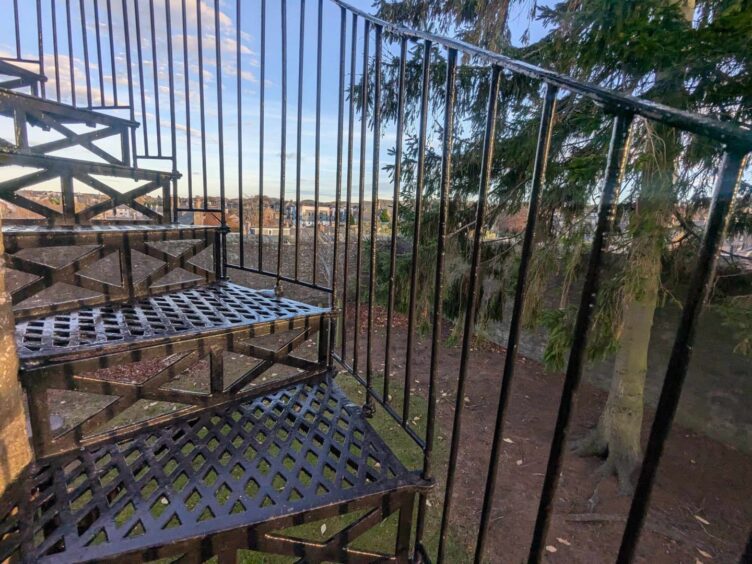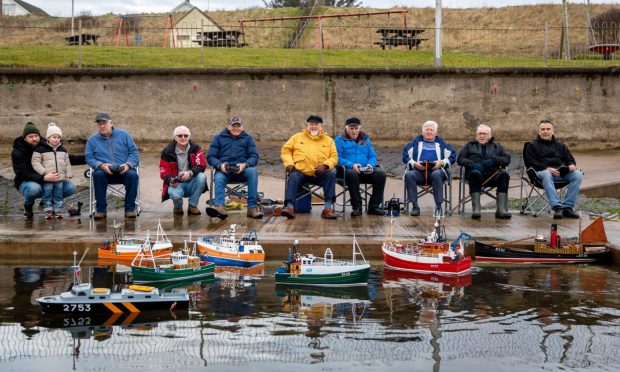Track down the big key, open the ornate gate and hike up the quaint cobbled lane. There, at the top, you’ll find the secret tower.
It sounds like an adventure straight out of a Famous Five novel.
The thing is – pretty much anyone can take on this exciting quest, regardless of Enid Blyton.
I’ve lived in Angus for almost 13 years but never once have I thought to seek out Castle Hill, which is indisputably one of Forfar’s historical hidden gems.
Having heard a friend extol its virtues, I decided, finally, to check it out for myself last month.
The sun was setting as I began my mission.
Where do you find the key?
Stage one was to locate the special key required to access the site, and I was told I’d find this in Ali’s Newsagent on Castle Street.
Inside, the friendly shopkeeper, Asif Yaqoob, nodded and smiled as I told him of my adventure.
Handing me the giant key and pointing me in the right direction, off I went.
The site is hidden just off Canmore Street but if you know what you’re looking for, it’s pretty obvious.
Once I’d unlocked the quirky wrought iron gate, I stepped onto a quaint cobbled lane, which led quite steeply uphill.
What’s at the top of the hill?
At the top, in a secluded spot, is Castle Hill monument – an impressive tower, or castellated turret.
It’s actually the old 17th Century Mercat Cross that once stood in the town centre.
The tower sits in a grassy area, with trees and shrubs at its base, and some wooden benches on which you can pause and drink it all in.
An information board tells the history of the castle and the Mercat Cross, and if you shimmy up the winding spiral staircase, you’ll find a viewfinder.
The views are absolutely stunning – of Forfar, the surrounding countryside, and the distant Angus glens.
Councillor’s dreams for Castle Hill
The site enjoyed a makeover in 2018 thanks to work co-ordinated by Forfar Action Network, Angus councillor Lynne Devine, local historian Norman Atkinson and the council’s parks department.
Keen to build on the town’s history, Lynne launched a heritage trail and produced an accompanying booklet. You can download it from the Visit Angus app.
Lynne’s ambition was to make Forfarians – and those from further afield – aware of Castle Hill’s existence.
She hoped to see plays being enacted in the quiet spot, teachers taking their classes up for a recce and historical talks being given.
That has happened – as have a handful of weddings.
Lynne told me: “I do hope more people go up Castle Hill to explore some of the town’s history. It’s such an unknown gem.
“It’s a chance to see Forfar and the glens from a different angle.”
Asif, she said, takes his responsibility as key holder “very seriously”, and is keen to safeguard the site.
Lynne hopes to get more planting done at Castle Hill in spring, as some of the area is “a bit sparse”.
Hidden history in a secluded spot
I, however, found it a gorgeous spot – it felt a bit “far from the madding crowd”, despite the busy main streets of Forfar being just below me.
So what of the history of Castle Hill?
The hill was once the site of the 11th Century Royal Castle of Forfar, which was apparently surrounded by water.
It was used by the Scottish kings Malcolm III, William I and Alexander II.
“The loch used to come right up to the Castle Hill and what is now the Greens Car park was fully covered,” said Lynne.
“The remains of a boat were discovered there when the loch was drained and can now be seen in the Meffan Museum.”
Armies, attacks and demolition
While Malcolm used the castle as a base for raising an army to repel Danish invaders, it was surrendered to the English and garrisoned by Edward I of England, who visited it in 1296.
During the Wars of Independence, William Wallace was reputed to have attacked the castle and on Christmas Day in 1308 it was captured again by Robert the Bruce.
On Bruce’s orders the castle was destroyed to ensure that it could not be held again by the English.
It was never rebuilt on the hill, although successive Scots kings including Robert stayed in Forfar – probably in a royal manor on a hill to the west, now Manor Street.
Thick walls were found during building works in 1843 and 1935, but most of the castle’s stones were likely quarried for the construction of nearby houses.
History of the Mercat Cross
Today, the old Mercat Cross – originally located at the Cross in Forfar – stands where the castle once stood. But why is this?
The Cross, built in 1684 by Alexander Adam of Glamis, was considered an obstruction to traffic in 1799, and was subsequently removed and rebuilt on Castle Hill.
The council purchased a road to the hill and in 1828 enclosed the area with large stone walls and planted trees.
Iron stairs were added to the tower, allowing it to be used as a lookout tower.
The Mercat Cross, meanwhile, has its own horrible history.
The first one was erected at the town’s Cross in 1140, when Forfar became a royal burgh. Markets were held at it and proclamations were made from it.
Brutal murder
It’s known that the original cross was still there in 1230: there are reports of the brains of the infant daughter of Gillescop Mac William, a competitor for the throne to Alexander III, being dashed out at its base.
Horrific stories aside, Forfar is well worth a wander. It’s steeped in history and Castle Hill is up there among the many heritage highlights.





















Conversation